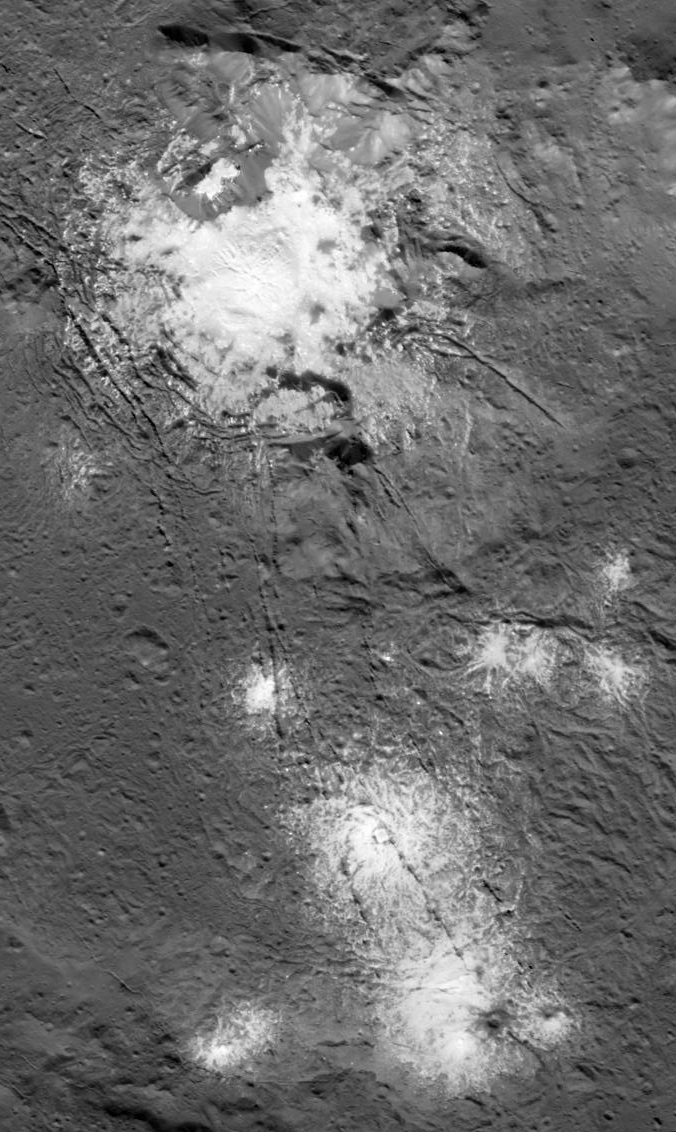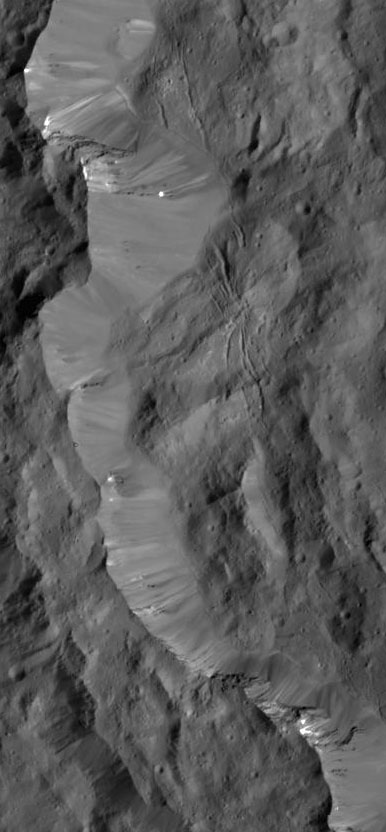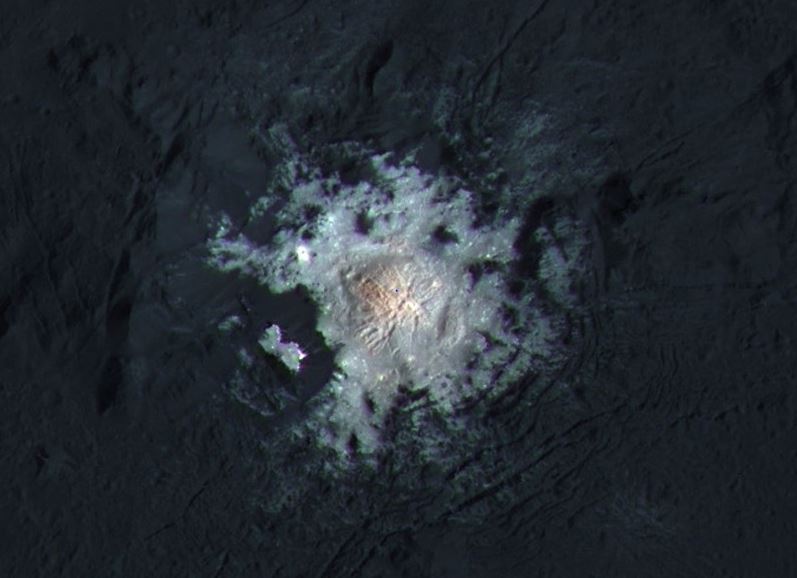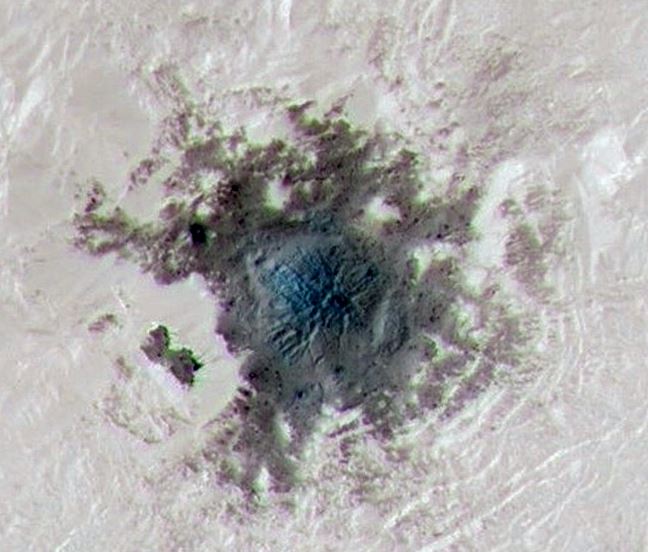It looks like you're using an Ad Blocker.
Please white-list or disable AboveTopSecret.com in your ad-blocking tool.
Thank you.
Some features of ATS will be disabled while you continue to use an ad-blocker.
share:
Wasn't sure what forum to put this in, so please move if it's in the wrong spot.
Anyways, I saw on spaceweather.com that closer images of Cere's "Bright Spots" have been released.

Here's a link to the article on spaceweather. Instead of linking to the main site, I am linking to the archive of the article so anyone who views it after today will still be able to read it.
spaceweather.com...
Mystery still remains.
I did a quick search and didn't see this posted on here yet. I'm mostly a lurker here who occasionally replies in threads, but when I saw this article and didn't see it posted anywhere on here, I knew I had to post it. At first my plan was to find the old ATS chat room and tell the good people in there about it so perhaps they could make a thread for it as I have very little experience, and like I said, I'm mostly a lurker. Sadly, I discovered that chat room is long gone.
I'm also not sure if this is considered content from other websites since it's news, if so, please delete, I just hope someone will see this and create a proper article of it here.
Back to lurking I go...
Anyways, I saw on spaceweather.com that closer images of Cere's "Bright Spots" have been released.

Here's a link to the article on spaceweather. Instead of linking to the main site, I am linking to the archive of the article so anyone who views it after today will still be able to read it.
spaceweather.com...
Last year, NASA's Dawn spacecraft went into orbit around Ceres, a dwarf planet in the asteroid belt. Immediately, researchers were mesmerized by a number of bright spots peppering the planet's charcoal-gray surface. What were they? No one knew, but they hoped that close-up images taken during a low orbit in Feb. 2016 might crack the mystery. Yesterday, those images were released.
Mystery still remains.
"The intricate geometry of the crater interior suggests geologic activity in the recent past, but we will need to complete detailed geologic mapping of the crater in order to test multiple hypotheses for its formation," says Ralf Jaumann of the German Aerospace Center. He is a member of the Dawn science team that released the new images at the 47th annual Lunar and Planetary Science Conference in The Woodlands, Texas, on March 22nd.
I did a quick search and didn't see this posted on here yet. I'm mostly a lurker here who occasionally replies in threads, but when I saw this article and didn't see it posted anywhere on here, I knew I had to post it. At first my plan was to find the old ATS chat room and tell the good people in there about it so perhaps they could make a thread for it as I have very little experience, and like I said, I'm mostly a lurker. Sadly, I discovered that chat room is long gone.
I'm also not sure if this is considered content from other websites since it's news, if so, please delete, I just hope someone will see this and create a proper article of it here.
Back to lurking I go...
edit on 3/24/2016 by digitalbluco because: got upload to work finally
a reply to: digitalbluco
Loving the detail in that pic in your OP, it looks like some kind of geological process to my layman eyes.
An ambitious suggestion, but an exciting idea.
edit: quote is from OP's link spaceweather.com...
Loving the detail in that pic in your OP, it looks like some kind of geological process to my layman eyes.
One idea gaining favor is that the bright area might be a crust of salt marking the spot where a briny underground ocean briefly broke through to the surface. If so, Ceres might not be as dry as it looks. Indeed, the density of Ceres suggests that 1/3rd of its mass is H2O, and some researchers think Ceres contains more freshwater than Earth itself.
An ambitious suggestion, but an exciting idea.
edit: quote is from OP's link spaceweather.com...
edit on 24/3/2016 by BelowLowAnnouncement
because: (no reason given)
I can still make out the alien cities I predicted in the firstly released images!
shut up! I can dream damn you!!!!
shut up! I can dream damn you!!!!
edit on 24/3/16 by Ghost147 because: (no reason given)
Definitely looks like salt / mineral deposits.
Here's an un-enhanced high-rez image (actually a mosaic)
photojournal.jpl.nasa.gov...
photojournal.jpl.nasa.gov...

There's a very interesting rectangular feature atop one of the smaller bright spots.
Here's an un-enhanced high-rez image (actually a mosaic)
photojournal.jpl.nasa.gov...
photojournal.jpl.nasa.gov...

There's a very interesting rectangular feature atop one of the smaller bright spots.
Looks like spaceweather cut that image out and did some effects on it.
A link to the full image in the OP
www.nasa.gov...
From
www.nasa.gov...
A link to the full image in the OP
www.nasa.gov...
The bright spots of Occator Crater are shown in enhanced color in this view from NASA's Dawn spacecraft. Such views can be used to highlight subtle color differences on Ceres' surface.
From
www.nasa.gov...
edit on 3/24/2016 by digitalbluco because: Added quote
a reply to: wildespace
Odd looking terrain.
Of course, it is another planet(oid). So I guess it would depend on your point of view.
Odd looking terrain.
Of course, it is another planet(oid). So I guess it would depend on your point of view.
originally posted by: Phage
a reply to: wildespace
Odd looking terrain.
Of course, it is another planet(oid). So I guess it would depend on your point of view.
Folk at the Unmanned Spaceflight Forum seem to get a good grip on the geology and topography of the bright spot: www.unmannedspaceflight.com...
Evidently the impact that created Occator Crater punched through into the subsurface ocean of Ceres, and created a weak spot that has henceforth served as a conduit for cryovolcanic outflows.
The main bright spot is inside of what appears to be a volcanic caldera, a depressed area with concentric cracks around (and inside) its perimeter, produced through the collapse of the roof of a "magma" chamber after its contents were extruded. And in the center of the caldera we have fresh dome-building, where slush is apparently pushing up (quite possibly in preparation for another significant eruption in the future), and this has caused radial cracks in the center (on the slopes of the dome) where the crust has been stretched.
a reply to: digitalbluco
Excellent find. I've been wondering when we'd get better images.
Now that we have them it's pretty clear. This is a flare-up of space herpes.
S&F.
Excellent find. I've been wondering when we'd get better images.
Now that we have them it's pretty clear. This is a flare-up of space herpes.
S&F.
Does anyone else think the crater edge is almost as interesting as the central region? It's very similar to the dust/brine outflows on craters around
Mars.

Image directly to the left of the central 'caldera'.

Image directly to the left of the central 'caldera'.
WOW! Incredible detail. What an amazing shot.
Just wow.
Those look like concentric (ish) rings on the left side to me. Thanks Op
Just wow.
Those look like concentric (ish) rings on the left side to me. Thanks Op
edit on 24-3-2016 by 3danimator2014 because: (no reason
given)
a reply to: digitalbluco
Looks like there's a mound there, a mound of material. I predicted it would be such, more than a year ago!
From my prediction in January 2015:
Most people back then predicted the Bright Spot was an area where the soil of Ceres had been removed, showing ice underneath. I was the first to propose that the Spot was actually a mound or a boulder protuding from the surface of Ceres.
Hehe, looks like I was right! S&F op for sharing!
Looks like there's a mound there, a mound of material. I predicted it would be such, more than a year ago!
From my prediction in January 2015:
I don't think it's ice either - Ceres has no insulating atmosphere, the Sun would have evaporated the ice.
Probably a giant boulder of some different material.
Most people back then predicted the Bright Spot was an area where the soil of Ceres had been removed, showing ice underneath. I was the first to propose that the Spot was actually a mound or a boulder protuding from the surface of Ceres.
Hehe, looks like I was right! S&F op for sharing!
edit on 24-3-2016 by swanne because: (no reason given)
a reply to: digitalbluco
You guys don't see it?

Just kidding
I wish we could see these up close with a home telescope! It's awesome to be able to see these features on a moon which before all we know was "it's ice" or "it's rock" - For a good portion of my life, I actually believed many of the bodies in the solar system were bland, essentially featureless spheres of nothing interesting. This is awesome - and more amazing discoveries to come in our future!
You guys don't see it?

Just kidding
I wish we could see these up close with a home telescope! It's awesome to be able to see these features on a moon which before all we know was "it's ice" or "it's rock" - For a good portion of my life, I actually believed many of the bodies in the solar system were bland, essentially featureless spheres of nothing interesting. This is awesome - and more amazing discoveries to come in our future!
a reply to: digitalbluco
It reminds me of images I've seen of Io. Could it be an interstellar old faithful?
It reminds me of images I've seen of Io. Could it be an interstellar old faithful?
Evidently a left over of surface mining.
Aliens needs salts too.
Aliens needs salts too.
It was a domed alien city, just like I said it was!
(Actually, that wasn't me.)
(Actually, that wasn't me.)
so that`s "suppose" to be the same spot?
The same spot that glowed like a billion watt halogen light from a gazillion miles away but up close it doesn`t even reflect enough light to cause lens flare?
yeah ok.
The same spot that glowed like a billion watt halogen light from a gazillion miles away but up close it doesn`t even reflect enough light to cause lens flare?
yeah ok.
originally posted by: Tardacus
so that`s "suppose" to be the same spot?
The same spot that glowed like a billion watt halogen light from a gazillion miles away but up close it doesn`t even reflect enough light to cause lens flare?
yeah ok.
You are free to belive that Nasa are lying, but what would be the point in them doing that about Ceres?
The reason it was much brighter in the original images is because they increased the brightness of the images since Ceres is so dark. Its albedo is around 0.090 according to wikipedia, our moons is around 0.12. Which means Ceres is very dark. Which means that the image would be almost all black with a white dot in the middle if they didn't pump up the brightness. Not very interesting.
Now they got much closer and high res images, they don't have to brighten it up as much (you can see the images are darker than the previous ones published)
Simple explanation eh? Of course, it could be that there is an alien colony on Ceres that they found and don't want to show us.
new topics
-
DOJ Special Counsel Robert HUR Says JOE BIDEN Can Be ARRESTED After Jan 20th 2025.
Above Politics: 10 hours ago
top topics
-
More Proof of Lawfare
US Political Madness: 16 hours ago, 20 flags -
DOJ Special Counsel Robert HUR Says JOE BIDEN Can Be ARRESTED After Jan 20th 2025.
Above Politics: 10 hours ago, 8 flags
active topics
-
Results of the use of the Oreshnik missile system in Dnepropetrovsk
World War Three • 231 • : andy06shake -
Ok this is some BS now WTH
Rant • 23 • : doctordark -
I thought Trump was the existential threat?
World War Three • 55 • : andy06shake -
Anyone like the Scorpions?
Music • 16 • : andy06shake -
Well, here we go red lines crossed Biden gives the go ahead to use long range missiles
World War Three • 368 • : andy06shake -
The Acronym Game .. Pt.4
General Chit Chat • 987 • : JJproductions -
DOJ Special Counsel Robert HUR Says JOE BIDEN Can Be ARRESTED After Jan 20th 2025.
Above Politics • 10 • : angelchemuel -
Petition Calling for General Election at 564,016 and rising Fast
Political Issues • 89 • : angelchemuel -
-@TH3WH17ERABB17- -Q- ---TIME TO SHOW THE WORLD--- -Part- --44--
Dissecting Disinformation • 3379 • : brewtiger123 -
Mood Music Part VI
Music • 3715 • : Hellmutt


